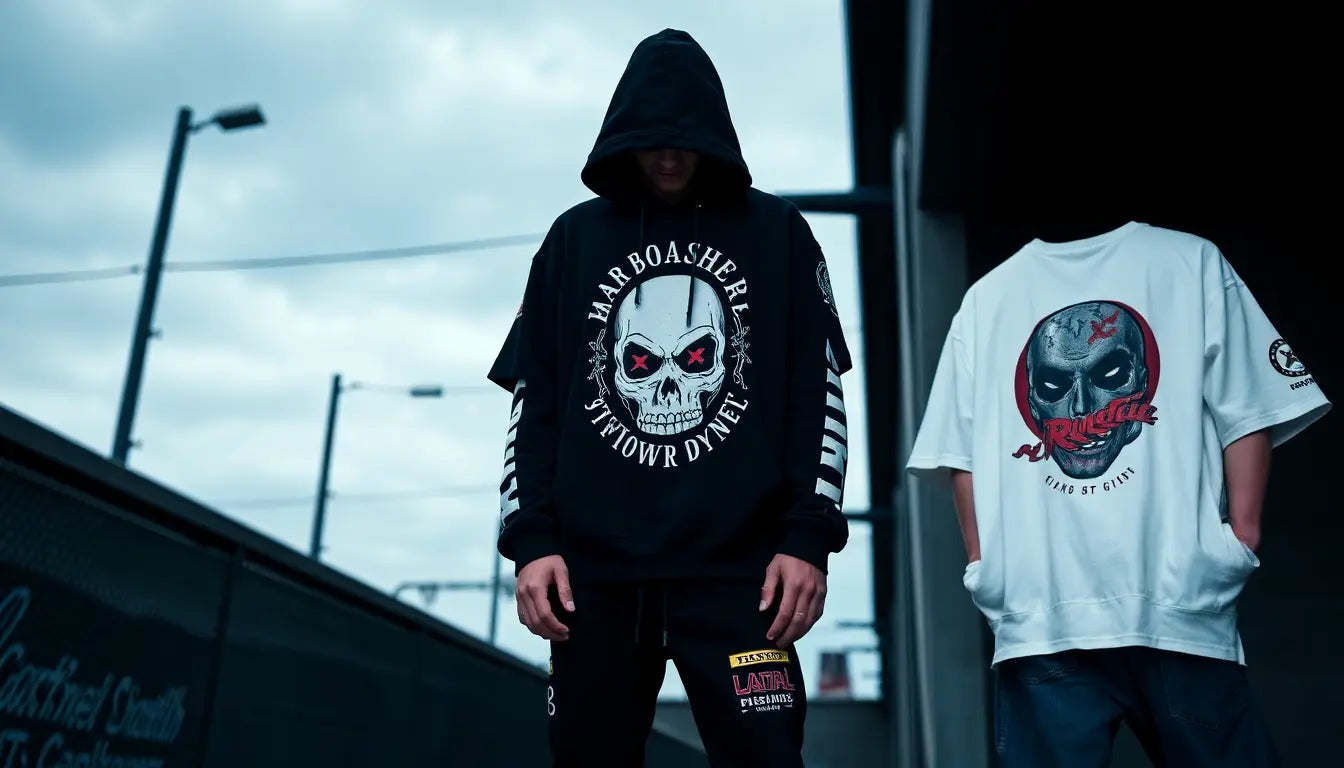
From Drops to Marketplaces: Tommy Lee Sparta's Blueprint for Scaling Dancehall Streetwear Globally
Introduction
In 2025, the cross-pollination of music and fashion has matured into one of the strongest engines for independent brand growth. Dancehall — with its raw energy, visual codes, and deeply loyal communities — is uniquely positioned to create streetwear brands with global traction. This article lays out a comprehensive, tactical blueprint inspired by Tommy Lee Sparta's persona and the broader dancehall movement: how to move from viral drops to sustainable marketplace distribution while preserving culture, control, and margin.
Why This Blueprint Matters
- Artists and cultural creators increasingly rely on merchandise and apparel as primary revenue streams.
- Scaling from drops to marketplaces requires balancing scarcity (cultural value) with accessibility (market reach).
- Without deliberate strategy, brands risk losing authenticity, profitability, or both as they expand.
Context: Dancehall Culture + Brand Potential
Dancehall's visual language — its silhouettes, symbols, slang, and performance contexts — creates built-in product differentiation. Fans often seek physical expressions of identity beyond music: shirts, hoodies, hats, and bespoke pieces worn in clubs, at shows, and on social channels. When a music artist like Tommy Lee Sparta attaches those visual cues to well-designed garments and well-timed drops, the result can be deep fan loyalty and high shareability.
Ethical Note and Scope
This article is a strategic blueprint inspired by public persona and industry best practices. It offers practical tactics for artists, small labels, and entrepreneurs aiming to scale dancehall streetwear worldwide. It is not a journalistic report of an individual artist's private business activities.
Core Principles of a Sustainable Scaling Strategy
- Culture-First Design: Product must feel authentic to the music and community.
- Scarcity With Access: Use limited drops to drive demand and marketplaces to extend lifecycle.
- Direct Relationship: Own customer data and first-party channels to preserve margins.
- Operational Discipline: Systems for manufacturing, fulfillment, and returns prevent growth from collapsing under complexity.
- Data-Informed Creativity: Use sales and engagement data to guide design and production.
Product Strategy: From Signature Pieces to Full Collections
Design and assortment should move from a tight core to a broader lifestyle catalog strategically.
- Signature Pieces: Start with 3-5 hero SKUs representing the artist's visual identity (eg. a graphic tee, embroidered hoodie, denim jacket, cap, and an accessory).
- Essentials Layer: Add daily-wear basics in reliable colors and fits to generate repeat sales and steady cash flow.
- Limited Editions: Create numbered, artist-signed, or collaboration pieces to fuel hype and collectability.
- Seasonal Capsules: Release 2-4 seasonal capsules per year to refresh core, tied to tour dates or music releases.
- Collaborative Lines: Work with designers, sneaker brands, or local artisans to expand credibility and distribution.
Design, Materials, and Quality Control
- Design System: Create a style guide — logos, color palettes, typographies, and motifs — to ensure consistent storytelling across drops.
- Material Choices: Prioritize mid-weight cottons for tees and hoodies, use durable trims and quality prints/embroidery for longevity.
- Quality Checks: Establish inspection points with manufacturers for first-sample approval, pre-shipment inspection, and random QC on batches.
- Sustainable Options: Consider organic cotton, recycled polyester, and transparent supply chains to appeal to conscious buyers and wholesale partners.
Pricing Architecture
- Tiered Pricing: Maintain three tiers — accessible basics, premium core, and collectible limited items.
- Cost-Plus Modeling: Use BOM (bill of materials) plus overhead and target margin to set wholesale and DTC pricing.
- Psychological Pricing: Use round numbers for premium pieces and slightly lower thresholds for mass-appeal items to increase conversion.
- International Pricing: Localize prices for key markets to avoid abandoned carts due to high shipping or customs fees.
Drop Strategy — The Mechanics
Drops create cultural moments. To scale, formalize the mechanics around each release.
- Pre-Drop Phase: Teasers, lookbooks, designer interviews, product details, and limited pre-orders for VIPs.
- Launch Phase: Precise launch time, shoppable livestream, and scarcity indicators (low stock warnings, countdowns).
- Post-Drop Phase: Restock strategy, marketplace distribution of remaining inventory, and community content amplification.
- Anti-Bot Measures: Use verified fan lists, CAPTCHA, queue systems, and randomized releases to deter bots and scalpers.
- Data Capture: Collect emails, phone numbers, and first-party signals at pre-order and checkout for future retargeting.
Direct-to-Consumer (DTC) Best Practices
DTC is where brand identity, margins, and customer data converge.
- Platform: Use a flexible commerce stack that supports headless storefronts and internationalization.
- Checkout Optimization: One-page checkout, guest checkout, local payment methods, and saved payment options improve conversions.
- Localization: Translate core pages, show local currencies, and provide localized shipping estimates before checkout.
- Post-Purchase Experience: Send tracking updates, style suggestions, and a next-purchase incentive to convert one-time buyers into repeat customers.
- Loyalty: Implement a points or membership program tied to early access for drops, exclusive content, and discounts.
Marketplace Strategy — Where and When to Expand
Marketplaces accelerate discovery but require careful selection and staging.
- Stage 1 — Curated Resale and Streetwear Platforms: Use StockX, Grailed, and Stadium Goods for limited and collector items to build prestige and tap collector audiences.
- Stage 2 — Fashion Marketplaces: Expand to Farfetch, Zalando, and MR PORTER for designer collaborations and premium placements when signaling quality is key.
- Stage 3 — Mass Marketplaces: Introduce selected basics on Amazon or ASOS Marketplace once you have the inventory, customer service, and returns process standardized.
- Stage 4 — Regional Marketplaces: Expand to Jumia, Mercado Libre, Shopee, and Lazada to reach local customers where e-commerce behavior favors marketplaces over DTC.
- Staging Tactics: Always release first on DTC, then drip select SKUs to marketplaces to extend lifecycle and capture different buyer personas.
Marketplace Operations and Seller Health
- Listings: Optimize product titles, bullet points, and images for each marketplace using localized keywords and cultural references where appropriate.
- Inventory Sync: Use a centralized inventory management system with real-time sync to prevent overselling.
- Performance: Monitor marketplace metrics daily — fulfillment time, return rate, customer messages, and seller rating.
- Fees & Margin: Model marketplace fees and shipping costs into pricing. Use selective SKUs for marketplaces to protect margin.
Marketing Deep Dive — Music, Content, and SEO
Marketing must blur the line between musical output and product promotion.
- Content Pillars: Music drops, behind-the-scenes production, lookbooks, fan stories, and design rationale.
- SEO Strategy: Build content around long-tail keywords such as dancehall streetwear, Tommy Lee Sparta merch, limited dancehall drops, and regional queries. Use product schema, descriptive alt text, and canonical tags to consolidate SEO value.
- Video Strategy: Short-form video on TikTok and Instagram Reels tied to drops; longer documentary-style content on YouTube detailing design and cultural context.
- Music Integration: Embed shoppable links in music video descriptions, lyrics videos, and artist websites. Time product drops with single or album releases to maximize cross-traffic.
- Paid Media: Use retargeting funnels, UGC-focused creative, and platform-specific testing (TikTok TopView for brand awareness; prospecting on Facebook/IG; Google Shopping for high-intent buyers).
- Influencer Program: Tiered approach with micro-influencers for authenticity and macro-influencers for reach. Track conversions using promo codes and affiliate links.
Community and Fan Engagement
The most valuable asset is a community that feels ownership over the brand.
- Community Platforms: Host exclusive channels on Discord, Telegram, and private Instagram Close Friends for VIP access and early drops.
- Events & Pop-Ups: Use pop-ups during tours and in cultural hubs to create IRL moments and drive press coverage.
- Member Perks: Offer exclusive merch, meet-and-greets, pre-listing access, and collaborative voting on designs.
- User-Generated Content: Encourage fans to share styling, unboxings, and live event photos. Run periodic UGC contests tied to merch rewards.
Retail, Wholesale, and Partnerships
- Retail Trials: Start with short-term pop-ups and trunk shows in key cities to test product-market fit and price elasticity.
- Wholesale Selectivity: Partner with stores that align with brand identity — streetwear boutiques, skate shops, and urban fashion retailers — rather than broad wholesale distribution early on.
- Collaborations: Partner with footwear brands, local artisans, or cultural institutions to co-create limited releases and gain access to new audiences.
- Licensing: Protect designs and consider licensing to larger manufacturers for certain product categories while retaining control of core drops.
Logistics, Fulfillment and Returns
- Fulfillment Options: Use a hybrid model — third-party fulfillment centers in priority regions plus in-house packing for collector items that require personalized touches.
- Shipping Strategy: Offer clear shipping estimates, local pickup where possible, and transparent duties and taxes to avoid surprise costs on delivery.
- Returns: Implement a simple, localized returns process and analyze returns by SKU to inform quality and fit adjustments.
- Packaging: Create on-brand, reusable packaging for premium SKUs to elevate the unboxing experience and promote social sharing.
Technology Stack Recommendations
- Commerce Platform: Shopify Plus or a scalable headless commerce architecture for flexibility and integrations.
- ERP/PIM: Use a product information management system and an ERP to consolidate SKUs, pricing, and inventory across channels.
- WMS & 3PL Integrations: Integrate the warehouse management system with your commerce platform for real-time availability.
- Analytics: Centralize metrics in a BI tool to combine sales, marketing, and supply chain KPIs.
- Anti-Fraud Tools: Use bot mitigation and fraud detection plugins to protect launches and payments.
Legal, IP and Brand Protection
- Trademarks: Register brand marks and logos in priority markets to protect against knockoffs.
- Design Protection: Use copyright and design patents where applicable for unique pieces.
- Counterfeit Mitigation: Track listings on secondary marketplaces and issue takedowns where necessary. Use authentication features like QR codes or NFC tags for high-value limited items.
- Contracts: Use clear agreements with manufacturers, designers, and collaborators covering ownership, royalties, and returns.
Sustainability and Ethics
Increasingly, consumers expect social responsibility. Integrate ethical sourcing into scale plans to protect brand reputation and open wholesale doors.
- Supplier Audits: Require ethical labor certifications from partners.
- Material Transparency: Label materials and provide care instructions to improve product longevity.
- Carbon Considerations: Measure shipping emissions and offer offset options for customers at checkout.
Financial Planning and Unit Economics
- Gross Margin Targets: Aim for at least 50-60% gross margin on DTC for apparel to support marketing and operations.
- Break-Even Volume: Model fixed costs (design, tooling, marketing) vs variable cost per unit to determine minimum viable batch sizes.
- LTV:CAC: Target a long-term customer LTV at least 3x customer acquisition cost for sustainable marketing spend.
- Cash Flow: Use pre-orders, limited releases, and phased payments to suppliers to manage cash during growth spurts.
Data & KPIs — What to Measure Weekly and Monthly
Track a balanced scorecard of performance and cultural health.
- Weekly: Website visitors, conversion rate, cart abandonment rate, units sold by SKU, marketplace sales, social engagement rate.
- Monthly: AOV, repeat purchase rate, LTV, gross margin, returns rate, sell-through per SKU, influencer-driven conversions.
- Quarterly: Market expansion performance, fulfillment SLAs, trademark infringement incidents, and partnership ROI.
Risk Management and Contingency Planning
- Supply Chain Disruption: Keep a secondary supplier and use buffer stock for hero SKUs.
- PR Crises: Maintain a media playbook and a spokesperson to preserve brand narrative when controversies arise.
- Financial Shocks: Keep a reserve fund and limit extended credit terms early in marketplace expansion.
- Overexposure: Avoid releasing everything at once; maintain scarcity to protect perceived value.
18-Month Roadmap with Milestones
- Months 1-3: Finalize brand guide, launch DTC store, release 2 micro-drops, collect first-party data, set up analytics and inventory systems.
- Months 4-6: Pilot marketplace listings on 1-2 curated platforms, run influencer micro-campaigns, launch first pop-up aligned with a music event.
- Months 7-9: Expand to 1 regional marketplace, finalize 3 collaborations, set up 3PL in a second continent, launch membership program.
- Months 10-12: Introduce wholesale to select boutiques, increase quarterly capsule production, optimize returns and customer service playbook.
- Months 13-18: Scale marketplaces in 3 regions, open flagship pop-up in a key city, reach profitability on core SKUs, consider licensing deals and limited streetwear drops tied to major music releases or tours.
Sample SEO & Content Calendar (90 Days)
- Week 1-2: Publish brand story and product pages with primary keywords. Launch press release tied to artist content.
- Week 3-4: Release behind-the-scenes video and long-form blog on the design inspiration for the first capsule (optimize for long-tail queries).
- Week 5-8: Run short-form video campaigns showcasing fits, UGC challenges, and influencer try-ons. Amplify with PPC targeting specific apparel keywords.
- Week 9-12: Release a music-single with embedded shopping links and a limited edition merch drop. Publish case studies and press outreach highlighting drop performance.
Checklist: Pre-Launch Readiness
- Brand style guide and product content finalized.
- Manufacturing and QC approvals completed.
- Shop functionality, checkout, and payment methods tested.
- Shipping and returns flow live and tested.
- Marketing assets ready: product photography, video, and influencer briefs.
- Analytics dashboards created and linked to attribution tools.
- Customer support processes and templates documented.
Realistic Growth Scenarios
Expect three growth phases:
- Phase 1 — Local Credibility: Focused DTC and community building, break-even on initial collections.
- Phase 2 — Regional Expansion: Marketplaces and pop-ups broaden reach and create repeat customers across neighboring countries.
- Phase 3 — Global Scaling: Multiple marketplace channels, robust logistics, and licensing deals drive sustained revenue.
Conclusion — Authenticity, Discipline, and the Long Game
Scaling dancehall streetwear from drops to marketplaces is less about a single viral moment and more about a disciplined system. The most successful projects preserve artistic authenticity while professionalizing the commerce engine: rigorous design systems, thoughtful drop mechanics, selective marketplace expansion, and an ownership-first DTC strategy. By combining those elements with a deep respect for the culture and a commitment to operational rigor, artists and entrepreneurs can build brands that survive trends and thrive globally.
Next Steps You Can Act On Today
- Map three signature SKUs and produce prototypes for fit testing this month.
- Set up a DTC storefront with product schema and a simple pre-order flow to validate demand without heavy inventory risk.
- Create a 90-day content plan that synchronizes music drops and product launches with clear SEO targets.
- Choose one curated marketplace to pilot within 3 months and allocate resources to manage seller health and customer experience.
Want a tailored 12- or 18-month blueprint for your project that maps product, marketing, logistics, and financials to your fanbase and budget? Start by sharing your current product list, audience metrics, and geographical priorities — and build a roadmap that scales culture-first.



